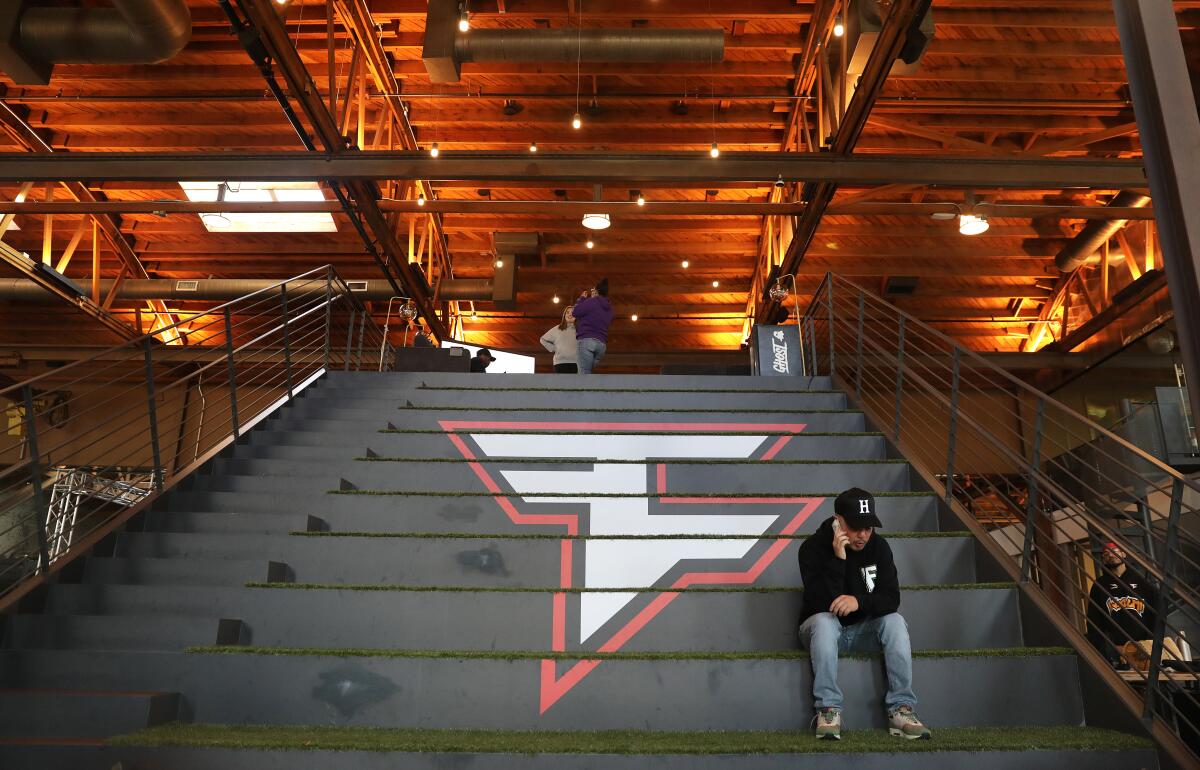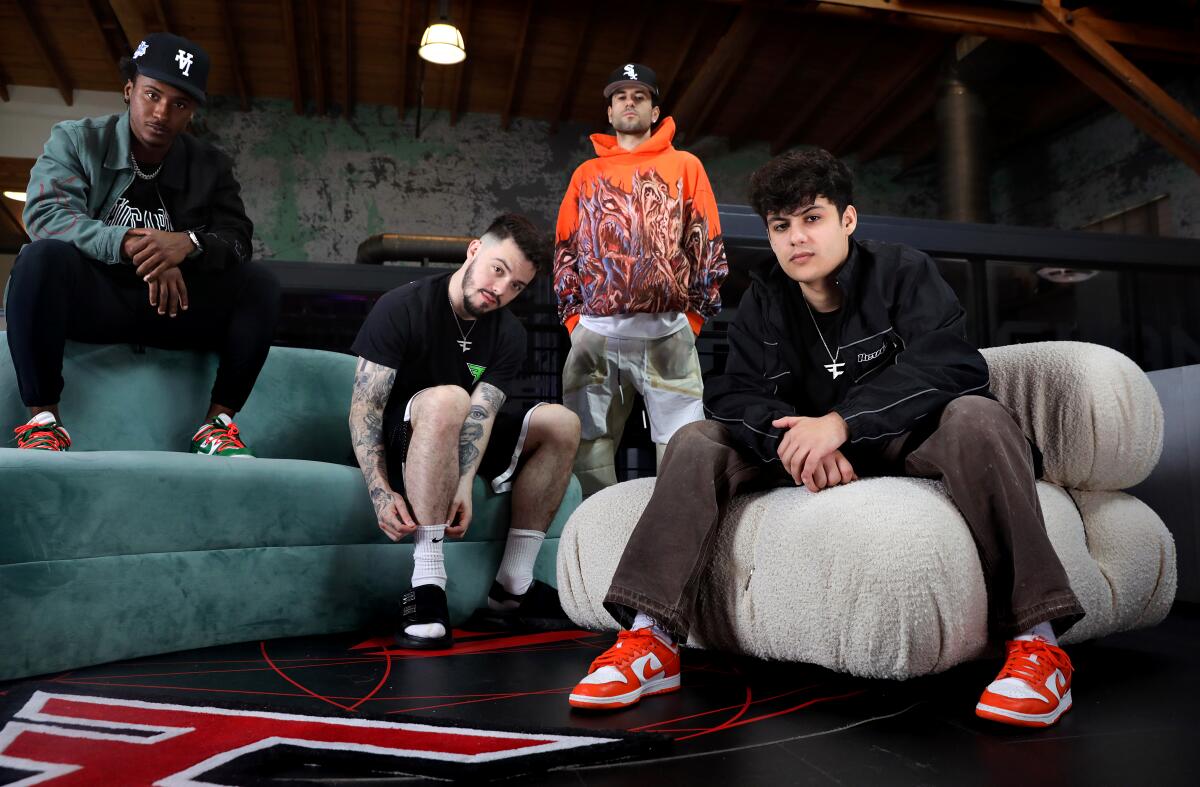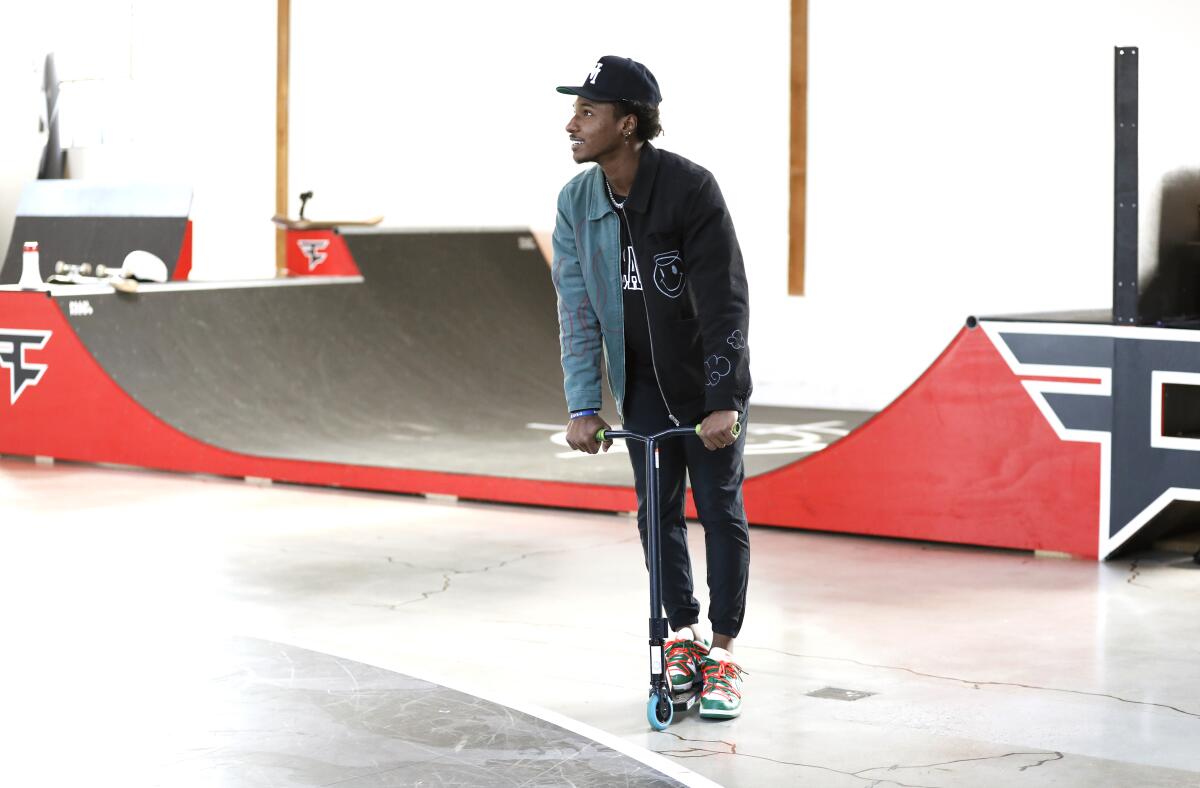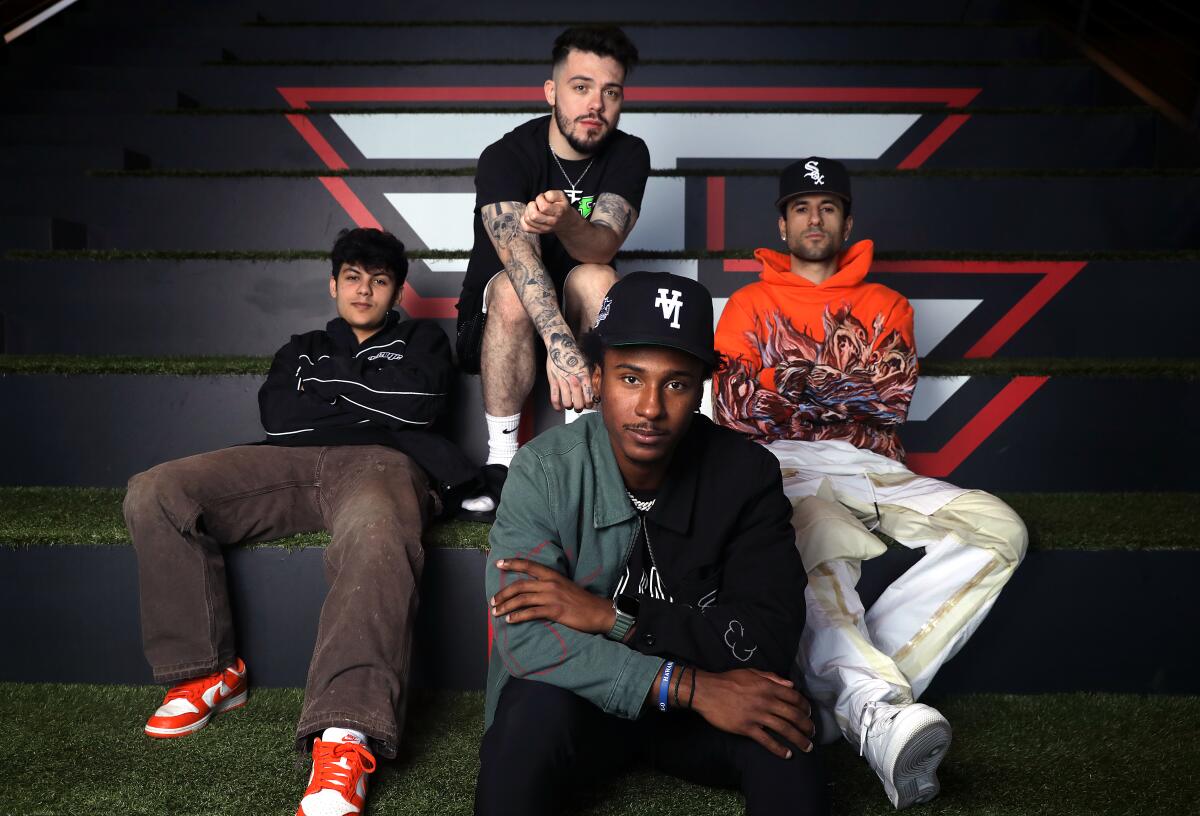How one Hollywood company is placing its bets on internet stars

More than 1,000 people came to see Brian Awadis.
They queued up outside the Hollywood headquarters of his parent company, FaZe Clan, in a line that snaked around the block: a gaggle of eager preteens, streetwear-clad high-schoolers and beleaguered parents slowly inching down Melrose Avenue.
Many waited hours to brush shoulders with the vlogger, who regularly entertains an audience about as big as the population of Sri Lanka.
‚ÄúI would literally love to meet every single person,‚ÄĚ Awadis, standing on a stage inside the warehouse-like office, told the fans who‚Äôd already made it in. ‚ÄúMy team tells me it‚Äôs impossible.‚ÄĚ
Those outside Awadis‚Äô orbit might be puzzled as to how he can draw such a large crowd. With just a handful of credits on IMDb ‚ÄĒ all as himself ‚ÄĒ he‚Äôs hardly your standard celebrity; after a brief stint in Los Angeles, the 26-year old San Diegan moved back south to be closer to home.
Yet on the internet, or at least certain corners of it, he‚Äôs something of a Big Deal. Twenty-two million people follow him on YouTube, his platform of choice, where he posts high-concept pranks and lavishly funded stunts. More still keep up with his life on TikTok (9.6 million), Instagram (6.6 million) and Twitter (2.6 million). Under the handle FaZe Rug, he‚Äôs spun off all this online clout into a custom energy drink, a short-lived podcast and, recently, a signature DoorDash sandwich called the ‚ÄúRugfather.‚ÄĚ
It was this sandwich partnership that brought him and his legions of fans out in droves for the Hollywood meet-and-greet.
‚ÄúI love him,‚ÄĚ said Ethan Comingore, 15, of San Bernardino. ‚ÄúI watch him day and night.‚ÄĚ
There‚Äôs a lot of money in all of this ‚ÄĒ both from the fans who loyally wait for hours on the sidewalk in hopes of fist-bumping their favorite YouTube star and the brands that, as with DoorDash, want access to the sizable soapboxes Awadis and other big-name social media personalities enjoy.
Enter FaZe Clan, the sprawling web content and lifestyle brand that organized the event this summer. It‚Äôs among many companies trying to capitalize on the huge demand. This summer, the firm went public in a reverse merger valued at $725 million ‚ÄĒ with mixed results.
That number undershot an earlier projection of $1 billion, and the company’s share price has plummeted since then. After FaZe Clan debuted at around $13 a share, but amid a broader tech sector downturn, the price has dropped considerably, closing at $2.44 on Friday.

‚ÄúGoing public gave us a balance sheet that we‚Äôve never had before...in order to really invest in the current business [and] build the future,‚ÄĚ Chief Executive Lee Trink said.
Sitting somewhere at the intersection of management agency, record label and artists collective, FaZe is largely built around influencers, streamers and web personalities with ties to the world of video games. The company also fields esports teams and makes money lining up sponsorship deals with brands.
FaZe makes regular forays into hip-hop, pro sports and fitness, and it has pondered ventures in gambling and crypto. Though still heavy on gamers, it’s added Lil Yachty, LeBron James Jr. and Snoop Dogg as affiliates. The latter wore a FaZe-branded chain during his Super Bowl halftime show earlier this year.
It‚Äôs all part of a company-wide pivot from gamer to youth culture ‚ÄĒ a broader, albeit less defined, market ‚ÄĒ that‚Äôs been percolating since FaZe‚Äôs early days.
FaZe began in 2010 when a group of teenagers started posting ‚ÄúCall of Duty‚ÄĚ trick-shots on YouTube. It grew from there, making a name for itself among video game fans and branching out into esports teams, influencer ‚Äúcontent houses‚ÄĚ and other ventures. Today, it has roughly 100 employees.
Awadis got recruited for his skills in gaming but expanded into lifestyle vlogging and other personality-driven content, as did some of his colleagues.
The result has been a company that defies pigeonholing. In a 2021 investor presentation, FaZe suggested that it combined MTV’s generational appeal, Disney’s cross-platform reach, Roc Nation’s celebrity cachet and the NBA’s fan loyalty.
The company reported $14 million in revenue in the third quarter, up 12% over the same period last year (about half from brand deals). The firm also reported a pre-tax loss of $12 million this quarter, reflecting costs from hiring and going public. That same loss was $4.1 million a quarter earlier.
It‚Äôs not the only firm trying to turn ‚Äúlikes‚ÄĚ and shares into a sustainable business model. Indeed, with so much money sloshing around the creator economy, there are a lot of financial incentives to spin off individual influencers into larger business ventures.
Some have started their own retail brands. Others have moved into ‚Äúcontent houses‚ÄĚ so they can live and work together under a shared identity. Still more have linked up for structured creative collaborations, such as a ‚ÄúSaturday Night Live‚ÄĚ-esque TikTok comedy revue. FaZe isn‚Äôt even alone in trying to blend gamer culture with social influence: The L.A.-based brand 100 Thieves has attempted something similar.
It’s an industry that relies heavily on the unique charms of specific web personalities. That can make it lucrative but also risky; if those personalities burn out, get canceled or just slowly start to lose the internet’s fickle interest, a lot of the value and reach they had to offer goes with them.
‚Äú[FaZe Clan] have a bunch of influencers and creators, of course, but Twitch and YouTube and TikTok are much bigger, and none of them has the answer on how to monetize and scale,‚ÄĚ said Michael Pachter, managing director for equity research at Wedbush Securities, whose portfolio covers gaming and digital entertainment.
Disputes with influencers can also crop up. Influencer Alissa Marie Violet Butler sued FaZe Clan last year over company shares she said she was owed (the firm denied her complaints). That same year, FaZe removed three members for their alleged promotion of a cryptocurrency ‚Äúpump and dump‚ÄĚ scheme; a fourth was suspended but later invited back. And in 2020, streaming personality Turner Tenney settled a contract dispute with the company after alleging that they‚Äôd exploited him.
In a 2021 investor presentation, FaZe cited as a risk factor how ‚Äúa limited number of esports professionals, influencers and content creators historically have accounted for a substantial portion of our revenue.‚ÄĚ

A big part of FaZe’s pitch to new talent is its logistical support. It offers affiliated creators help with wrangling sponsorship deals and access to in-house management, publicity, legal, merchandising and sales teams, and it thinks of itself as an incubator for emerging creatives.
‚ÄúAny business like this, if you‚Äôre going to be on the cutting edge of youth culture, you better have the people that are closest to the ground,‚ÄĚ said Trink.
Among those new voices is Gabriel Gélinas, a Canadian streamer from Quebec who was admitted onto the roster earlier this year under the name FaZe Proze after winning a recruitment competition.
‚ÄúFaZe has been doing a great job of trying to evolve and innovate,‚ÄĚ said G√©linas, 24. ‚ÄúThat‚Äôs why I feel like they‚Äôre always looking for new people.‚ÄĚ
Another recent addition to the slate ‚ÄĒ Donald De La Haye, or FaZe Deestroying ‚ÄĒ said the company has everything he could‚Äôve asked for in a partnership: ‚Äúthe infrastructure, the business mind, the capital, the knowledge.‚ÄĚ
A former college football kicker, De La Haye was deemed ineligible for the NCAA in 2017 after he refused to stop earning ad revenue from his YouTube channel. These days, he makes videos about football and sports culture with FaZe’s logistical support.

‚ÄúThey definitely help me take things off my plate,‚ÄĚ said De La Haye, 25.
It’s not always clear how much of FaZe’s popularity comes from the overarching brand versus individual members’ star power.
‚ÄúI don‚Äôt really watch FaZe ‚ÄĒ I just watch FaZe Rug‚Äôs videos,‚ÄĚ Kevin Isais, 13, said while standing in line for the DoorDash meet-and-greet.
Indeed, FaZe Clan’s corporate YouTube channel has less than 40% the followers that Awadis’ personal one does.
Awadis is one of the most-followed creators on the company‚Äôs roster, so he‚Äôs not necessarily representative ‚ÄĒ and FaZe still has more fans than him on Instagram and Twitter. Even still, it raises the question: Who needs whom more?
‚ÄúI‚Äôm like the CEO of my own company, but then I‚Äôm also a part of FaZe,‚ÄĚ Awadis said. ‚ÄúSo my stuff helps FaZe and vice versa.‚ÄĚ
But keeping the larger institution stable can sometimes mean shifting around its composite parts.
Yousef Abdelfattah, known online as FaZe Apex, was a member of the brand back when it was just a few teenagers posting ‚ÄúCall of Duty‚ÄĚ trick-shots online. But as FaZe grew, Abdelfattah started handling some of its day-to-day managerial work.
‚ÄúI was always kind of doing the ‚ÄĒ I don‚Äôt want to say annoying work, but the less exciting stuff,‚ÄĚ he said. ‚ÄúIn 2016-17, when the business was more matured and when we had an office, we had employees, I started balancing content creation with ‚Ķ decision-making.‚ÄĚ
These days, a lot of Abdelfattah‚Äôs time is spent mediating between the firm‚Äôs management and talent ‚ÄĒ the resident gamer whisperer, as it were.

‚ÄúContent creation is very demanding,‚ÄĚ he said, ‚Äúand that spark, I think, kind of died out. ‚Ķ I got lucky that when I hit that wall, I was able to still be super-involved in the company I love.‚ÄĚ
The 26-year-old has also adopted a mentorship role among recruits. One of the newer teenage members calls him a ‚Äúboomer.‚ÄĚ
Internet culture shifts fast, and the 12-year-old FaZe is practically a legacy brand at this point. Still, it‚Äôs continuing to change ‚ÄĒ even if that means evolving beyond the people and ideas it started with.
‚ÄúIt‚Äôs more of a group effort now,‚ÄĚ Abdelfattah said. ‚ÄúAll of us [early members] have brought in people that we know understand the internet, understand this world, that can help us stay on track. ... We‚Äôre just constantly trying to build a monster team of internet geniuses.‚ÄĚ
More to Read
Inside the business of entertainment
The Wide Shot brings you news, analysis and insights on everything from streaming wars to production ‚ÄĒ and what it all means for the future.
You may occasionally receive promotional content from the Los Angeles Times.











